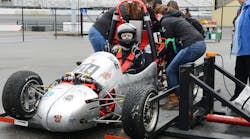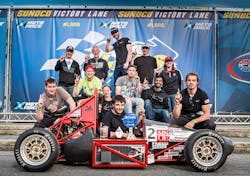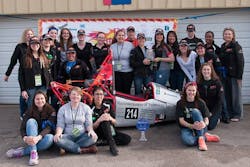The Formula Hybrid Competition is an interdisciplinary design and engineering challenge that targets undergraduate and graduate university students. Focusing more on the engineering side than on racing, the teams must collaboratively design and build a formula-style electric or plug-in hybrid race car and subsequently compete in a series of events. The competition is part of the Society of Automotive Engineers (SAE) Collegiate Design Series.
There are two competition fields—hybrid and electric. The hybrid category perhaps is the most challenging of all the SAE Collegiate Design Series engineering competitions, as it typically requires thousands of hours of engineering and development time. Formula Hybrid is the only competition that requires the full cooperation of mechanical engineers, electrical engineers, and computer scientists in the planning and building of their cars. Formula Hybrid teams must also optimize energy efficiency and incorporate sustainable materials when building their vehicles.
Students compete in aspects of vehicle design, acceleration, handling, and endurance while abiding by rules that minimize risk yet still preserve the students’ freedom to innovate. This year, the 19 teams from the U.S., Canada, and India developed a total of 12 hybrid and 9 electric vehicles.
All teams have sponsors that lend support in a variety of ways. Sponsors can donate cash, components, materials, mentorship, or even services like machining, welding, or painting. Among the sponsors were the IEEE, Ford, Toyota, Analog Devices, Eaton, Bosch, Mentor Graphics, The MathWorks, Mentor Automotive, PSIM, West Coast Magnetics, and more.
1. The Mozee Motorsports team took the first place in the Hybrid Category at the Formula Hybrid competition. (Courtesy of Mozee Motorsports)
The competition consists of dynamic and static events. The dynamic events included:
- Acceleration: The cars are evaluated on their accelerating abilities from a standing start in a straight line over a distance of 75 meters.
- Autocross: The objective is to evaluate the car’s maneuverability and handling qualities on a tight course without the hindrance of competing cars. The course combines the performance features of acceleration, braking, and cornering into one event.
- Endurance: The endurance event is the most challenging. Over a distance of 44 km, the cars have to prove their durability under long-term conditions. Acceleration, speed, handling, dynamics, fuel economy, and reliability all come into play. Each vehicle begins with fully charged accumulators (batteries or capacitors). These may be charged from the grid, as is the norm for a plug-in hybrid vehicle. Hybrids are then given an additional allocation of liquid fuel so that all hybrid vehicles start with the same amount of energy. Electric-only vehicles must complete the endurance event with the energy contained in their accumulators.
For their part, the static events include:
- Design: Here, the students explain their constructive solutions to a jury of experts from the automotive and motorsport industries via a report and through discussion. The concept of the design event is to evaluate the engineering effort that went into the design of the car and how the engineering meets the intent of the competition. The car that illustrates the best use of engineering to meet design goals and the best understanding of the design by team members will win the design event.
- Presentation: The objective of the presentation event is for teams to convince a review board that the project was carefully planned and executed effectively and dynamically. Constrained by scope, time, and budget, students will develop a project-management plan that demonstrates their skill and the techniques necessary to execute the project.
And the Winner is…
In the Hybrid Category, first place was captured by the Milwaukee School of Engineering. The Mozee Motorsports team (Fig. 1) made competition history by having the first hybrid car ever to complete all 44 laps in the endurance race. “The biggest challenge was a huge hill. We had to get up the hill while still saving energy,” said David Roulo, captain of the 64-member team. They were awarded with the FCA North America Industrial Design Award and the IEEE Engineering the Future Award.
2. Phoebe, the Hot Wheelz racecar, completed 31 of the 44 laps on the battery, the most laps completed by any all-electric team this year. (Courtesy of Hot Wheelz)
The all-female team from the Rochester Institute of Technology received first place in the Electric-Only Category. The RIT Hot Wheelz team (Fig. 2) also received the IEEE Excellence in Electric Vehicle Engineering. “One thing that really set our vehicle apart at competition was our custom battery packs and the ability to access information on our system from the stands while Phoebe, our car, was on the track,” said Missy Miller, team project manager and a fifth-year industrial and systems engineering student from Belvidere, N.J.
The Formula Hybrid Competition gives engineering students the chance to learn more about automotive design on both the mechanical and electrical sides. They even become well-versed in project management. Students who compete can benefit in many ways. For instance, they might have the chance to be recruited by one of the largest automakers in the world, as many sponsor the competition. Or on a more general level, it can help shape their careers or even lead to the discovery of new areas of interest after participating and networking for so many months with industry experts.



